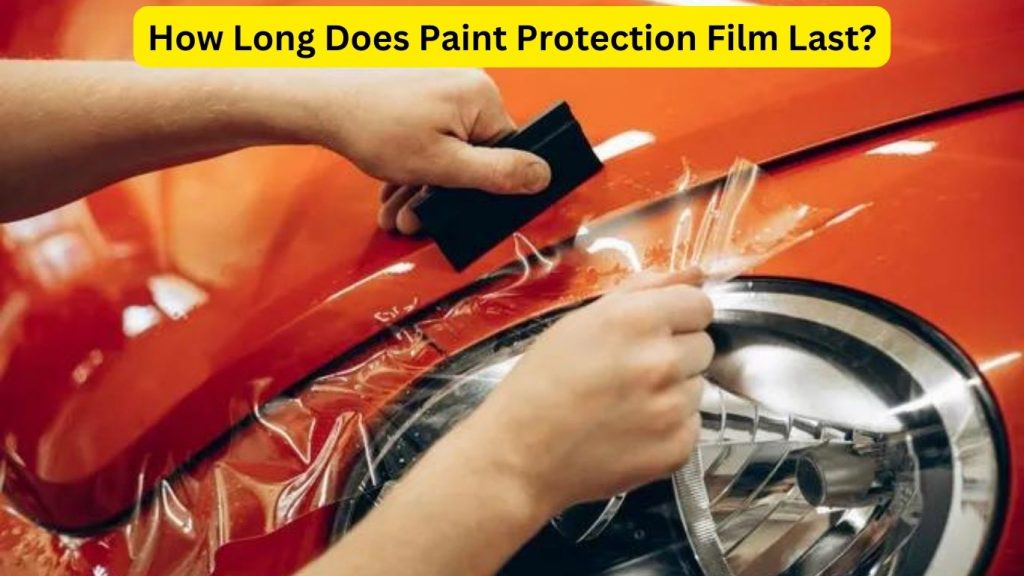Paint protection film (PPF) is a popular choice for safeguarding vehicles from scratches, chips, and other damage. But how long does it last? PPF longevity varies depending on factors like quality, maintenance, and environmental conditions.

Typically, high-quality PPF can last between five to ten years, providing durable protection. However, proper care, regular maintenance, and avoiding harsh conditions can extend its lifespan.
In this guide, we’ll delve into the factors affecting PPF durability, maintenance tips, and signs indicating it’s time for replacement, helping you make informed decisions to keep your vehicle protected for years to come.
Contents
What Is Paint Protection Film?
Paint Protection Film (PPF) is a transparent, thermoplastic urethane film applied to the exterior surfaces of vehicles to protect them from damage.
It acts as a sacrificial barrier, shielding the paintwork from scratches, stone chips, bug splatter, and other environmental hazards. PPF is optically clear, allowing the vehicle’s paint color and finish to remain visible while providing a high level of protection.
It is commonly used on areas prone to damage, such as the front bumper, hood, fenders, and side mirrors.
PPF offers long-lasting protection, preserving the vehicle’s appearance and resale value while minimizing the need for frequent touch-ups or repaints.
How Long Does Paint Protection Film Last?
Paint Protection Film (PPF) is a valuable investment for preserving your vehicle’s appearance and resale value. Understanding its lifespan is crucial for maintaining optimal protection.
In this comprehensive guide, we’ll explore the factors influencing the longevity of PPF, maintenance tips to extend its lifespan, signs indicating replacement, and more.
Whether you’re considering PPF installation or already have it on your vehicle, this guide will equip you with the knowledge to ensure long-lasting protection.
- What is Paint Protection Film (PPF)?
- Definition and purpose of PPF
- How PPF works to protect vehicle paint
- Factors Affecting PPF Lifespan:
- Quality of the film
- Thickness and type of PPF
- Installation quality
- Environmental factors (sun exposure, climate, etc.)
- Driving habits and road conditions
- Typical Lifespan of PPF:
- General lifespan range (5 to 10 years)
- Variations based on factors mentioned above
- Signs of PPF Wear and Degradation:
- Fading or discoloration
- Yellowing
- Peeling or lifting edges
- Scratches or damage to the film
- Maintenance Tips to Extend PPF Lifespan:
- Regular washing and waxing
- Avoiding harsh chemicals and abrasive cleaners
- Using a dedicated PPF cleaner and conditioner
- Parking in shaded areas when possible
- Prompt removal of contaminants and bug splatter
- Professional Inspection and Maintenance:
- Periodic inspection by a professional
- Addressing any issues or damage promptly
- Professional PPF maintenance and restoration services
- When to Replace PPF:
- Excessive wear or damage
- Beyond repair or restoration
- End of its expected lifespan
- PPF Removal and Replacement:
- Proper removal techniques
- Preparing the surface for new PPF installation
- Choosing quality PPF for replacement
- Cost Considerations and ROI:
- Balancing initial investment with long-term protection benefits
- Factors influencing PPF installation and replacement costs
- Conclusion:
- Recap of factors influencing PPF lifespan
- Importance of maintenance and care
- Ensuring continued protection for your vehicle’s paint with PPF
How To Make Paint Protection Film Last Longer?
To make paint protection film (PPF) last longer, follow these tips:
- Quality Installation: Ensure PPF is installed by a professional to minimize defects and ensure proper adhesion.
- Regular Maintenance: Wash your vehicle regularly to remove dirt, debris, and contaminants that can degrade the film over time.
- Use Gentle Cleaning Products: Avoid abrasive cleaners or harsh chemicals that can damage the PPF. Use a mild soap and soft cloth or sponge for cleaning.
- Waxing and Sealing: Apply a wax or sealant specifically designed for PPF to enhance its durability and resistance to environmental factors.
- Avoid Abrasive Contact: Be cautious when parking near bushes, trees, or abrasive surfaces to prevent scratches and damage to the PPF.
- Protect from UV Exposure: Park in shaded areas whenever possible to minimize UV exposure, which can cause the PPF to degrade and discolor over time.
- Prompt Repairs: Address any damage or lifting edges promptly to prevent further deterioration and maintain the integrity of the PPF.
- Professional Inspection: Periodically have the PPF inspected by a professional to identify any issues early and address them before they worsen.
By following these tips, you can prolong the lifespan of your paint protection film and keep your vehicle looking its best for years to come.
Final Words
Paint Protection Film (PPF) offers valuable protection for vehicle paint, but its lifespan depends on various factors.
By understanding these factors, following maintenance tips, and knowing when to replace PPF, you can maximize its effectiveness and preserve your vehicle’s appearance for years to come.
With proper care and attention, PPF provides long-lasting protection, ensuring your vehicle maintains its pristine finish and resale value.
